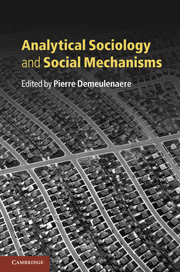Book contents
- Frontmatter
- Contents
- List of figures
- List of tables
- List of contributors
- Introduction
- Part I Action and mechanisms
- Part II Mechanisms and causality
- Part III Approaches to mechanisms
- 10 Youth unemployment: a self-reinforcing process?
- 11 Neighborhood effects, causal mechanisms and the social structure of the city
- 12 Social mechanisms and generative explanations: computational models with double agents
- 13 Relative deprivation in silico: agent-based models and causality in analytical sociology
- Index
- References
13 - Relative deprivation in silico: agent-based models and causality in analytical sociology
Published online by Cambridge University Press: 05 June 2012
- Frontmatter
- Contents
- List of figures
- List of tables
- List of contributors
- Introduction
- Part I Action and mechanisms
- Part II Mechanisms and causality
- Part III Approaches to mechanisms
- 10 Youth unemployment: a self-reinforcing process?
- 11 Neighborhood effects, causal mechanisms and the social structure of the city
- 12 Social mechanisms and generative explanations: computational models with double agents
- 13 Relative deprivation in silico: agent-based models and causality in analytical sociology
- Index
- References
Summary
Introduction
The concept of relative deprivation is one of the most frequently used notions in economics (see Clark et al. 2008), in social psychology (see Tyler et al. 1997: ch. 2; Walker and Smith 2001: ch. 1) and in sociology (see Cherkaoui 2001; Coleman 1990: ch. 8; Lundquist 2008). Despite its diffusion, formal analyses of the mechanisms generating rates and feelings of relative deprivation are far less common.
In sociology, the most notable exceptions are, on the one hand, Boudon's (1982: ch. 5; 1979: 52–6) analysis – later taken up by Kosaka (1986) and Yamaguchi (1998) – and, on the other, Burt's (1982: ch. 5, 191–8) contribution.
These analyses, however, have a different focus. The first group have the following characteristics:
They are interested in the rates of relative deprivation.
They tend to demonstrate that the relation between objective opportunity structure and proportion of dissatisfied actors can be both negative and positive.
They implicitly refer to actors who compare themselves with a given group as a whole (global comparisons).
By contrast, Burt's model can be characterized as follows:
It focuses on the individual feelings of deprivation.
It does not address the question about the positive or negative nature of the relation between objective opportunity structure and the intensity of feelings of dissatisfaction.
It takes into account comparisons between people who are embedded in social networks (local comparisons).
My aim here is to develop a unified theoretical framework which enables us to analyze formally the relation between these different aspects at the same time.
- Type
- Chapter
- Information
- Analytical Sociology and Social Mechanisms , pp. 266 - 308Publisher: Cambridge University PressPrint publication year: 2011
References
- 11
- Cited by



